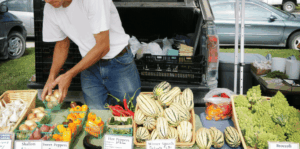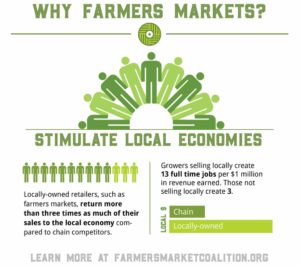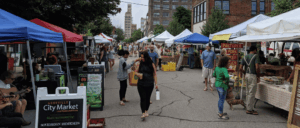In a world of shrink-wrapped vegetables and strawberries in December, eating local isn’t just a preference – it’s a revolutionary act for your health and that of your community.
It’s about reclaiming food transparency, honoring the seasons, protecting the planet, and investing in the strength of where you live.
More than ever, where you live can either make this lifestyle easy and joyful, or unrealistic and out of reach.
If you dream of living closer to your food, surrounded by thriving farmers markets, backyard gardens, and community-supported agriculture (CSA) networks, this guide is for you.
Why Eating Local Matters
Eating local isn’t just a cool thing to do – it’s actually foundational to health, sustainability, and personal sovereignty.
Shorter Supply Chains = Fresher, Nutrient-Dense Food
Local produce is typically harvested just 24–48 hours before it hits your plate, preserving flavor and nutrient content. In contrast, supermarket produce can spend up to two weeks in transit and storage, during which it may lose up to 50% of key nutrients like vitamin C and folate
That’s because nutrient degradation starts the moment food is harvested. Sensitive compounds like antioxidants, enzymes, and B vitamins break down quickly, especially under the stress of long-distance shipping and storage.
Local farms also tend to grow more diverse, nutrient-rich varieties bred for flavor and health, not just shelf life. The result? Fresher food that’s truly more nourishing – and often better tasting too.
Support for Soil Health and Biodiversity
Small, local farms are more likely to embrace regenerative agriculture – an approach that works with nature, not against it. By planting diverse crops, avoiding synthetic fertilizers, minimizing tilling, and creating pollinator habitats, these farms help rebuild soil health, preserve biodiversity, and support the ecosystem as a whole. Healthier soil means more nutrient-dense food, better water retention, and a stronger buffer against climate extremes.
Reduced Fossil Fuel Use and Packaging Waste
Local food travels shorter distances, often skipping the cross-country trucking and international shipping that conventional food relies on. That means fewer carbon emissions, less refrigeration, and drastically less plastic packaging. You’re not just supporting your health – you’re lightening your environmental footprint with every farmers market visit.
Boosting Food Security
Local food systems build resilience. When crises hit – be it supply chain disruptions, economic instability, or natural disasters – communities with strong regional agriculture can feed themselves. Eating local keeps nourishment close to home, reducing dependence on vulnerable global systems and ensuring consistent access to real food when it matters most.
Empowering Small Farmers and True Transparency
Unlike industrial food chains, local systems let you see your farmer, know their practices, and ask questions. It’s food with a face, not a barcode. Supporting local growers shifts power away from faceless corporations and back into the hands of people who steward the land with care. It’s not just a purchase – it’s a vote for transparency, ethics, and community resilience.

What Makes a Great Local Agriculture Hub?
Not every “green” city lives up to the hype. Here’s what to look for if you want your home base to truly support local food sovereignty:
- Thriving Farmers Markets
- As of April 2025, there are about 11,934 farmers markets operating across the U.S., up from under 2,000 in 1994.
- A strong local market scene is a direct pipeline to fresh, honest food.
- Community Supported Agriculture (CSA) Access
- CSAs offer direct farm-to-table boxes of produce, eggs, dairy, and meats. Since the 1980s, CSAs have exploded across the country, bringing food security and seasonality back to households.
- Policy Support for Urban and Rural Agriculture
- Cities that offer incentives for gardens, land access for young farmers, or food sovereignty programs give you more ways to grow or source food locally.
- Farm-to-Table Culture
- Restaurants that source from area farmers strengthen the economy – and offer some seriously good meals in the process.
- Climate and Biodiversity
- Regions with varied growing seasons or mild climates can sustain local harvests nearly year-round.
Top U.S. Cities and Regions for Local Food Enthusiasts
Here’s where local agriculture isn’t just surviving – it’s thriving:
1. Asheville, North Carolina
- Nicknamed “Foodtopia” for a reason.
- Dozens of farmers markets and a deeply rooted CSA and permaculture culture.
- Local policies encourage urban gardening and homesteading.
- Strong community around herbal medicine, fermentation, and sustainable food practices.

2. Burlington, Vermont
- Vermont ranks #1 in direct farm-to-consumer sales per capita.
- Burlington’s local food culture is deeply embedded, with heavy support from institutions like the Intervale Center.
- Year-round farmers markets – yes, even during winter.
3. Santa Fe, New Mexico
- Innovative desert farming using ancestral techniques and modern drip irrigation.
- Rich indigenous food traditions centered on corn, beans, squash, and chilies.
- Santa Fe’s farmers markets are packed with heritage foods you won’t find in a typical grocery store.

4. Portland, Oregon
- Over 50 farmers markets across the metro area.
- Progressive urban farming laws allow rooftop gardens, edible landscaping, and backyard chickens.
- Farm-to-table is standard operating procedure in Portland’s restaurants.
5. Madison, Wisconsin
- Hosts the nation’s largest producer-only farmers market.
- University-led agricultural research fuels innovations in sustainability.
- Affordable cost of living compared to coastal hubs, making land and local food more accessible.
Other Rising Stars
- Ithaca, NY: Vibrant co-ops, CSA abundance, and a deeply progressive food culture.
- Boise, ID: Emerging local food movement with a growing market and farm incubator programs.
- Missoula, MT: Exceptional community-driven initiatives for food security and young farmers.
How to Assess a Move Through the Local Food Lens
Relocating? Here’s how to vet your future town like a food freedom fighter:
- Use LocalHarvest.org
- Search by ZIP code for CSAs, farmers markets, and farm stands nearby.
- Investigate Policies
- Check city websites for urban agriculture ordinances, cottage food laws, and farmers market incentives.
- Visit a Farmers Market
- Talk to the sellers and the farmers to see what they are growing and how they do it.
- Find out if they participate in a CSA.
- Talk to Locals
- Ask about growing seasons, community gardens, food hubs, or farm volunteer opportunities.
- Peek at Local Menus
- Are restaurants shouting out local farms on their menus? That’s a good sign.
Bonus Tip:
Many food-secure communities also have seed libraries, local compost programs, and “gleaning” days where you can help harvest surplus food for free or donate.
Final Thoughts: Root Down, Rise Up
Choosing to live where real food grows close to home is about more than taste or trend.
It’s about health. It’s about sovereignty. It’s about community resilience in a chaotic world.
At a time when supermarket shelves are dominated by greenwashed branding and anonymous industrial foods, rooting yourself in a thriving local food system is radical sanity.
Find your place.
Root down.
Rise up.








